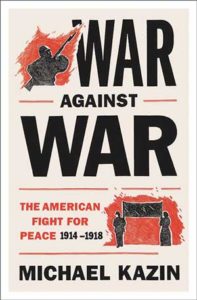War Against War: The American Fight for Peace, 1914–1918
Reviewed by Dave Austin
November 1, 2017
 By Michael Kazin. Simon & Schuster, 2017. 378 pages. $28/hardcover; $17/paperback (January 2018); $14.99/eBook.
By Michael Kazin. Simon & Schuster, 2017. 378 pages. $28/hardcover; $17/paperback (January 2018); $14.99/eBook.
Buy from QuakerBooks
This year marks the one-hundredth anniversary of America’s entry into the First World War, the conflict which, at the time, the world hoped and prayed would be “the war to end all wars.” However, it’s a centenary that has passed with surprisingly little attention. This may be because in the United States, World War I—unlike in Great Britain, France, or even Australia—is not a major part of our collective cultural consciousness. Beyond the occasional late-night airing of Sergeant York on cable, or the high school literature teacher who still assigns A Farewell to Arms, most Americans remain ignorant of the circumstances that drove America into the war, how and by whom it was fought, and the consequences of participating in that horrific conflict. And most of us are certainly unaware of the fact that a very vocal, very well-organized, and almost very successful antiwar movement—led largely by un-enfranchised women—fought its own “war” at home for three years to keep us out of it. This is the story told in Michael Kazin’s exhaustive history of that movement, War Against War: The American Fight for Peace 1914–1918.
Kazin’s chronicle of the anti-Great War movement focuses on the people and personalities at the heart of that movement. At the beginning of the second decade of the twentieth century, the American people were deeply divided about exactly what their role in the world should be. While celebrating the richness of our resources and the brilliant technological advances within our society, Americans were torn as to whether to assert themselves internationally, especially when a difficult-to-explain conflict broke out 3,000 miles away in Europe in the summer of 1914. Three years and millions of battlefield deaths later—the jaunty swaggering lyrics and music of George M. Cohan’s rousing “Over There” notwithstanding—most Americans still wanted absolutely nothing to do with the charnel house that Europe had become.
The American antiwar movement that began to speak out even before the slaughter in Europe began was populated by some of the most important progressive voices in modern American history. This list includes Samuel Gompers, “Fighting Bob” La Follette, and Nobel laureate Jane Addams, who plays a prominent role in Kazin’s version of events. Lesser-known (to contemporary audiences) leaders included Crystal Eastman, an atheist, communist, and suffragist; and most fascinating to me, Claude Kitchin, a Democratic member of Congress from North Carolina, a “true white son of Dixie who mingled together racist fears with a populist resentment against the wealthy barons of the North.” Pitted against them were the leaders of the so-called “preparedness movement,” led by former president Theodore Roosevelt, who not only wanted America to be ready to fight should it find itself attacked, but who believed that America had a moral, almost holy duty to enter the war, as a way of imposing itself onto the world order and taking what they believed was its rightful place as the preeminent world power. Seemingly stuck in the middle was President Woodrow Wilson, who also believed that America was uniquely situated—indeed destined—to be the leader of the world’s nations, but who struggled mightily for three years to fulfill that role via peaceful means.
While Kazin’s level of detail is remarkable, and the overall story fascinating, as a Quaker, I was left slightly disappointed by this book: I was hoping to find more about the opposition to the war mounted by Quakers and the other traditional peace churches in the United States. Friends get a few mentions throughout the text, but they are few, superficial, and far between. Additionally, conscientious objectors (some of them Friends) get very limited attention. But this book is a political study and those concerns are for another book by another author. What Friends can take from this book is the fascinating confluence of so many disparate elements within American society around the cause of peace. The antiwar movement of 1914–1918 was made up of Southern segregationists, Northeastern industrialists, Midwestern progressives, isolationists, socialists, pacifists, communists, conservatives, suffragettes, civil rights activists, trade unionists, faith leaders, and academics. While the predictable turf battles and personality clashes did occur, what strikes me about the sometimes unified, sometimes shaky coalition Kazin portrays is its dogged determination, its willingness to collaborate, and its ability to adapt and adjust.
It is not an exaggeration to say that the First World War changed the world. Besides causing the deaths of over 18 million people, it destroyed three empires, caused the collapse of a handful of monarchies, re-drew the maps of two continents, completely upset the balance of power in the world, advanced the technology of mass killing, and, unfortunately, laid the foundation for an even greater cataclysm which would begin less than a generation later. Michael Kazin’s book tells an important part of that story, one which can give those of us who still commit ourselves to the cause of peace the hope that movements matter, that coalition building can work, and that the struggle to end war and militarism needs to continue.



Comments on Friendsjournal.org may be used in the Forum of the print magazine and may be edited for length and clarity.